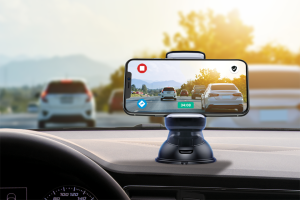Technology can be a double-edged sword when it comes to fleet management. On the one hand, the advent of GPS and dashboard cams has improved navigation on the road. On the other hand, drivers distracted by smartphones can wind up injuring themselves or others, or worse.
Distracted driving from smartphones claimed 3,522 lives in the United States in 2021, and according to the Insurance Institute for Highway Safety, the number of fatalities involving semi-trucks that year tallied 4,714, a 17% increase compared to the year prior.
“Distracted driving is a significant threat to our industry’s goal of zero highway fatalities,” said American Trucking Association Vice President of Safety Policy Dan Horvath in a written statement. “The trucking industry has long been subject to a mobile device ban, and we have seen the positive impact that reducing distractions can have, so we believe that extending similar bans to all drivers – or at the very least, encouraging all drivers to practice personal responsibility can improve safety.”
An encouraging report from the National Distracted Driving Coalition shows existing and emerging technologies have the potential to reduce distracted driving. Existing technologies include driver-monitoring systems, crash-avoidance features and even tech that blocks incoming calls or notifications while in motion. Although not required by law, many fleet managers and operators have become early adopters, already installing commercial vehicles with advanced driver assistance systems.
“Many people think of technology, especially smartphones and complicated ‘infotainment’ screens, as a major cause of distracted driving,” says Dr. Pnina Gershon, a researcher at Massachusetts Institute of Technology and co-author of the report. “While that’s true, other technologies can potentially help keep people focused on driving or help them avoid a crash if they are distracted.”
Newer vehicles already have many advanced safety features as standard equipment, which is of little help to the fleet manager seeking to keep their drivers safe on the road in trucks that, in all likelihood, are not the latest models. That being the case, after-market upgrades are the way to go. Yet, even in the after-market space, updating fleets with all these safety features can quickly balloon and become cost-prohibitive at scale.
Marcus Newbury, a co-founder of Driver Technologies, is among the companies looking to make managing fleet safety more manageable and affordable through technology. Its software turns smartphones into a driving safety tool by mounting them on the dashboard — a dashcam ‘hack’ — with all the benefits, less the financial investment, of introducing new technology to a distributor’s fleet.
“One of the biggest issues is driver distraction,” he said. “Most distraction is caused by cell phone use in your vehicle, and it’s such an addiction today, so how do we change that behavior? One way to change it is to take the phone out of your hand, mount it, and turn it into a life-saving device.”
While operating as a dashcam, the device provides forward collision alerts and detects distracted or drowsy driving using artificial intelligence. Data is stored in the cloud for individual drivers or fleet managers to easily monitor driving behaviors (like rolling through stop signs or tailgating). Newbury said the software could also record video using the phone’s cameras, as traditional telematics tend not to tell the whole story.

“Hard brakes aren’t always ‘bad driving’ behavior, and traditional telemetrics models will look at that as poor behavior and detrimental to your score, whereas we differentiate between ‘good’ and ‘bad’ hard braking,” he said.
Other software, like GPS Insight, can assist roofing distributors through features like real-time vehicle tracking, allowing fleet managers to monitor locations and ensure planned routes are followed.
“Driver behavior monitoring enables the identification of risky driving habits, allowing fleet managers to provide targeted training and enforce safety policies,” said Alex Firl, product manager for GPS Insights.
GPS Insight can also integrate with other safety features like dashboard cameras, providing a holistic view of fleet safety. Fleet managers can review recorded videos to identify improvement areas and offer feedback.
According to Firl, Trio Forest Products used GPS Insight’s tracking feature for years but wanted to improve driving habits and reduce the risk of accidents.
“When they installed the Driveri camera system, drivers triggered 102 safety events (harsh braking, speeding, running stop signs and traffic lights, etc.) in the first week alone,” Firl said. “Three months later, drivers had a 91% reduction in triggered safety events; Trio Forest Products also implemented an awards system to help incentivize drivers to stay safe, further strengthening the program.”
Safety Buy-In
Driver Technologies’ Newbury said he discovered a need in the market to provide employees with a safer driving experience after speaking with fleet owners and managers.
“Investing in these safety capabilities will ensure better outcomes for fleet drivers, as about 80% of drivers prefer having some tech that provides safety support features,” Newbury explained.
Safety is all good — and most drivers agree it’s important — but getting your drivers to embrace safety software and technology might be challenging. Firl said it takes careful planning and effective communication to encourage driver participation, even with something seemingly innocuous — and with apparent advantages — like GPS Insight. He said drivers are more likely to embrace these best practices by discussing the benefits of “enhanced” fleet management tools with them before moving forward.
“Foster a sense of involvement and ownership among drivers by including them in the decision-making process,” he said. “Seek their input, opinions, and concerns regarding the implementation of dash cameras. When drivers feel valued and included, they are more likely to embrace new technology and be supportive of its usage.”
Regarding recorded data and video, Firl said fleet managers should provide drivers with the necessary guidance to understand a system's features, how footage is recorded and accessed, and how it can enhance their driving skills. He recommends establishing a support system where drivers can ask questions, seek assistance, and share feedback.
“Proactively address any privacy concerns drivers may have regarding dash cameras,” he said. “Clearly explain how the technology is used and assure drivers that the primary focus is on improving safety and reducing risks. Reiterate that footage is typically only reviewed in the event of an incident or for coaching purposes, and strict privacy protocols are in place.”
Newbury said many programs like Driver could be adjusted so the video feature is only accessible to fleet managers in the case of an incident. If being recorded isn’t tenable for your drivers, fleet managers can remove video elements entirely from Driver so only a score is available.
“The employer can then address these safety issues with the entire team [anonymously] as areas of improvement,” Newbury said.
Besides keeping drivers safe, technology-enhanced fleet management can improve efficiency by reducing idle time and tracking fuel usage and vehicle maintenance. It can even enhance the customer service experience through reliable delivery times and updates, and in a worst-case scenario, it can track a vehicle should it be stolen.
“Fleet management software automates maintenance scheduling, tracks service history, and provides reminders for routine inspections,” Firi said. “This helps prevent vehicle breakdowns, reduces downtime, and ensures optimal vehicle performance.”









